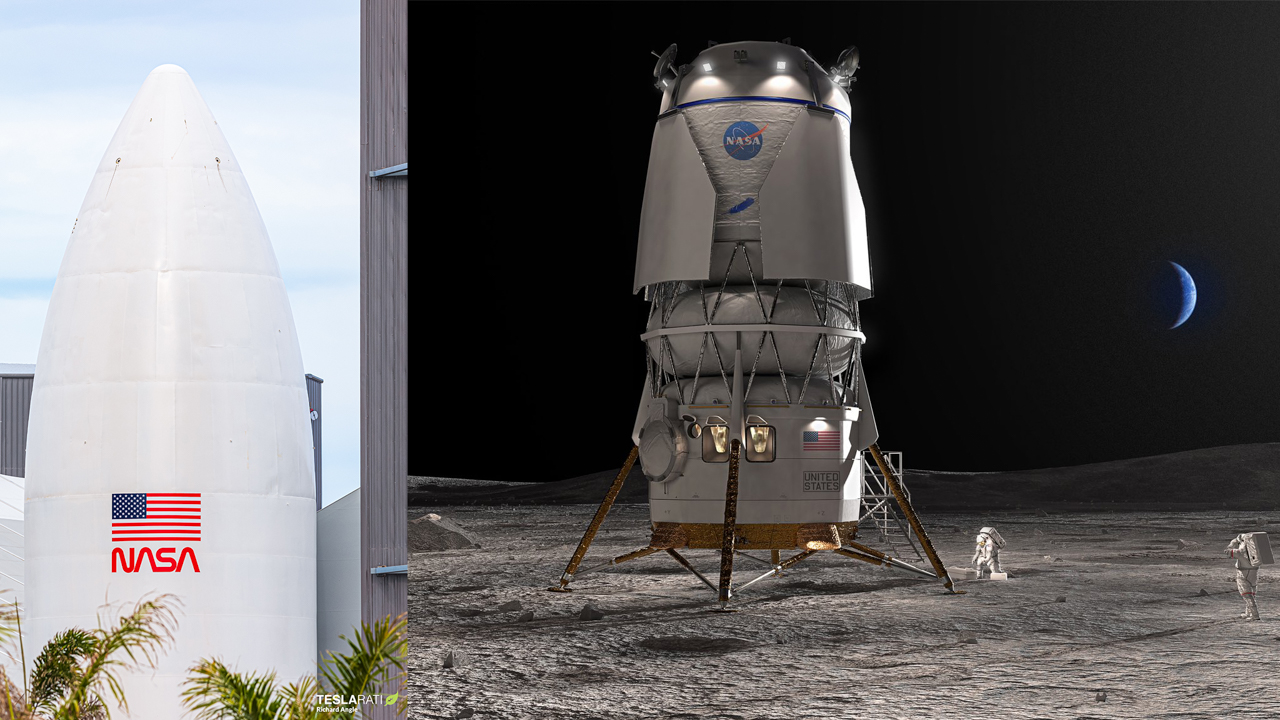NASA has awarded Blue Origin $3.4 billion dollars for its Human Landing System (HLS), Blue Moon. Blue Moon will launch atop their brand new rocket, New Glenn, and will support landing capabilities for Artemis V, currently scheduled no earlier than 2029.
NASA had originally only selected SpaceX to land their HLS variant, Starship, to land on the Moon and had awarded them $2.89 billion dollars.
However, it was met with multiple complaints, including a lawsuit from Blue Origin, which they subsequently lost. In the following months, NASA opened up a 2nd competition for another HLS in which teams from Blue Origin and Dynetics competed. Blue Origin’s Vice President John Couluris said they will also provide “well North of” the $3.4 billion dollar contract, bringing the total cost to ~$7 billion dollars.
We selected @BlueOrigin to develop the human landing system for the #Artemis V mission. This component for deep space transportation will help us in our goal of sending astronauts to the surface of the Moon and returning them home safely: https://t.co/KMq5fUn0ll pic.twitter.com/mpfUjWr6OX
— NASA (@NASA) May 19, 2023
The Blue Origin national team is comprised of Blue Origin, Lockheed Martin, Draper, Boeing, Astrobotic, and Honeybee Robotics. The Blue Moon lander will first perform an uncrewed demonstration landing no earlier than 2028 and, if all goes well, will then move forward with the Artemis V crewed landing on the Moon. The lander is also capable of flying in a cargo-only version.
To get to the Moon, Blue Origin will launch New Glenn with the unfueled lander in a 7-meter fairing into orbit, where it will meet with a fuel depot to fill the lander with propellant. Blue Moon would then proceed to NRHO (Near-Rectilinear Halo Orbit) to dock with Gateway, where Astronauts that arrived aboard Orion will then board Blue Moon lunar lander and proceed to land on the Moon.
Vice President John Couluris also indicated Blue Origin will perform two pathfinder landings at the Moon’s south pole prior to the Uncrewed demonstration landing. Seen below is a test of the BE-7 lunar lander engine.
Last week, our BE-7 team conducted another successful Thrust Chamber Assembly (TCA) test at NASA Marshall Space Flight Center Test Stand 116. Our tests on an upgraded TCA bring our cumulative test time to more than 4000 seconds, and we are on track in our engine development path. pic.twitter.com/LYdXfcInxl
— Blue Origin (@blueorigin) March 28, 2023
Once Blue Moon leaves the Lunar surface, it will dock once again at Gateway for the Crew to disembark and board Orion again for their trip back to Earth. The Blue Moon lander would then stay in NRHO and be capable of multiple landings on the Moon, only needing to refuel for future landings.
As of now, the HLS landers for future Artemis missions are the SpaceX Starship, which will land Astronauts on the Moon for Artemis III and Artemis IV, followed by Blue Origin landing Astronauts for Artemis V. NASA is most likely to use those landing systems for Artemis VI and beyond until a new HLS is announced in the future.


oral stromectol cost – buy stromectol online carbamazepine 200mg us
accutane over the counter – how to get dexona without a prescription order linezolid without prescription
azithromycin 500mg over the counter – nebivolol 20mg without prescription order nebivolol without prescription
buy omnacortil 40mg pills – buy prednisolone 40mg online cheap order generic prometrium 100mg
oral gabapentin 100mg – sporanox 100mg tablet buy sporanox generic
purchase augmentin without prescription – order augmentin 375mg without prescription generic cymbalta
buy doxycycline medication – buy glucotrol medication glipizide 10mg sale
buy augmentin 625mg online – amoxiclav pill where to buy cymbalta without a prescription
buy tadalafil 20mg without prescription – how much is cialis sildenafil pills 100mg
purchase sildenafil pills – sildenafil 100mg oral tadalafil 5mg over the counter
buy generic atorvastatin 10mg – buy atorvastatin 20mg without prescription buy zestril 5mg generic
cenforce 100mg for sale – aralen ca buy generic glycomet online
lipitor buy online – order norvasc 5mg generic prinivil generic
purchase lipitor pill – norvasc 5mg price prinivil without prescription
order prilosec 10mg pills – order prilosec pill tenormin 50mg usa
methylprednisolone 16 mg pills – methylprednisolone cost buy triamcinolone 10mg generic
cytotec us – order misoprostol without prescription diltiazem oral
acyclovir 800mg cheap – order generic zovirax 400mg order crestor pill
buy domperidone tablets – flexeril 15mg price purchase flexeril online cheap
inderal sale – methotrexate 2.5mg pill methotrexate 2.5mg us
where can i buy medex – metoclopramide 10mg pills losartan 25mg tablet
buy levaquin 500mg pill – levaquin 250mg drug zantac for sale online
nexium 20mg cheap – buy topamax 200mg for sale order imitrex 25mg generic
buy zofran 4mg pill – buy zofran 4mg online zocor order
buy valtrex 1000mg sale – purchase finasteride order fluconazole for sale